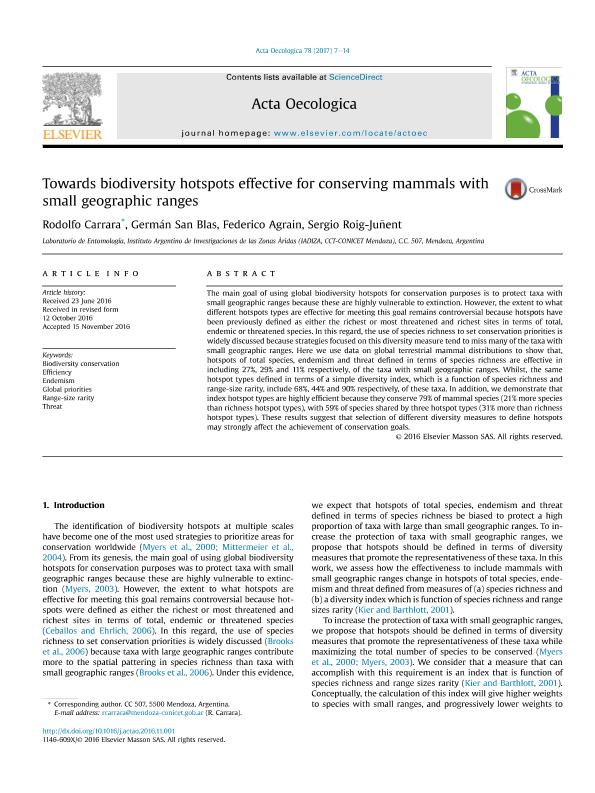Mostrar el registro sencillo del ítem
dc.contributor.author
Carrara, Rodolfo

dc.contributor.author
San Blas, Diego German

dc.contributor.author
Agrain, Federico Alejandro

dc.contributor.author
Roig, Sergio Alberto

dc.date.available
2018-05-15T19:01:54Z
dc.date.issued
2017-01
dc.identifier.citation
Carrara, Rodolfo; San Blas, Diego German; Agrain, Federico Alejandro; Roig, Sergio Alberto; Towards biodiversity hotspots effective for conserving mammals with small geographic ranges; Gauthier-Villars/Editions Elsevier; Acta Oecologica; 78; 1-2017; 7-14
dc.identifier.issn
1146-609X
dc.identifier.uri
http://hdl.handle.net/11336/45243
dc.description.abstract
The main goal of using global biodiversity hotspots for conservation purposes is to protect taxa with small geographic ranges because these are highly vulnerable to extinction. However, the extent to what different hotspots types are effective for meeting this goal remains controversial because hotspots have been previously defined as either the richest or most threatened and richest sites in terms of total, endemic or threatened species. In this regard, the use of species richness to set conservation priorities is widely discussed because strategies focused on this diversity measure tend to miss many of the taxa with small geographic ranges. Here we use data on global terrestrial mammal distributions to show that, hotspots of total species, endemism and threat defined in terms of species richness are effective in including 27%, 29% and 11% respectively, of the taxa with small geographic ranges. Whilst, the same hotspot types defined in terms of a simple diversity index, which is a function of species richness and range-size rarity, include 68%, 44% and 90% respectively, of these taxa. In addition, we demonstrate that index hotspot types are highly efficient because they conserve 79% of mammal species (21% more species than richness hotspot types), with 59% of species shared by three hotspot types (31% more than richness hotspot types). These results suggest that selection of different diversity measures to define hotspots may strongly affect the achievement of conservation goals.
dc.format
application/pdf
dc.language.iso
eng
dc.publisher
Gauthier-Villars/Editions Elsevier

dc.rights
info:eu-repo/semantics/openAccess
dc.rights.uri
https://creativecommons.org/licenses/by-nc-sa/2.5/ar/
dc.subject
Biodiversity Conservation
dc.subject
Efficiency
dc.subject
Endemism
dc.subject
Global Priorities
dc.subject
Range-Size Rarity
dc.subject
Threat
dc.subject.classification
Otras Ciencias Biológicas

dc.subject.classification
Ciencias Biológicas

dc.subject.classification
CIENCIAS NATURALES Y EXACTAS

dc.title
Towards biodiversity hotspots effective for conserving mammals with small geographic ranges
dc.type
info:eu-repo/semantics/article
dc.type
info:ar-repo/semantics/artículo
dc.type
info:eu-repo/semantics/publishedVersion
dc.date.updated
2018-04-18T14:56:03Z
dc.journal.volume
78
dc.journal.pagination
7-14
dc.journal.pais
Francia

dc.journal.ciudad
Paris
dc.description.fil
Fil: Carrara, Rodolfo. Consejo Nacional de Investigaciones Científicas y Técnicas. Centro Científico Tecnológico Conicet - Mendoza. Instituto Argentino de Investigaciones de las Zonas Áridas. Provincia de Mendoza. Instituto Argentino de Investigaciones de las Zonas Áridas. Universidad Nacional de Cuyo. Instituto Argentino de Investigaciones de las Zonas Áridas; Argentina
dc.description.fil
Fil: San Blas, Diego German. Consejo Nacional de Investigaciones Científicas y Técnicas. Centro Científico Tecnológico Conicet - Mendoza. Instituto Argentino de Investigaciones de las Zonas Áridas. Provincia de Mendoza. Instituto Argentino de Investigaciones de las Zonas Áridas. Universidad Nacional de Cuyo. Instituto Argentino de Investigaciones de las Zonas Áridas; Argentina
dc.description.fil
Fil: Agrain, Federico Alejandro. Consejo Nacional de Investigaciones Científicas y Técnicas. Centro Científico Tecnológico Conicet - Mendoza. Instituto Argentino de Investigaciones de las Zonas Áridas. Provincia de Mendoza. Instituto Argentino de Investigaciones de las Zonas Áridas. Universidad Nacional de Cuyo. Instituto Argentino de Investigaciones de las Zonas Áridas; Argentina
dc.description.fil
Fil: Roig, Sergio Alberto. Consejo Nacional de Investigaciones Científicas y Técnicas. Centro Científico Tecnológico Conicet - Mendoza. Instituto Argentino de Investigaciones de las Zonas Áridas. Provincia de Mendoza. Instituto Argentino de Investigaciones de las Zonas Áridas. Universidad Nacional de Cuyo. Instituto Argentino de Investigaciones de las Zonas Áridas; Argentina
dc.journal.title
Acta Oecologica

dc.relation.alternativeid
info:eu-repo/semantics/altIdentifier/doi/http://dx.doi.org/10.1016/j.actao.2016.11.001
dc.relation.alternativeid
info:eu-repo/semantics/altIdentifier/url/https://www.sciencedirect.com/science/article/pii/S1146609X16301138?via%3Dihub
Archivos asociados
